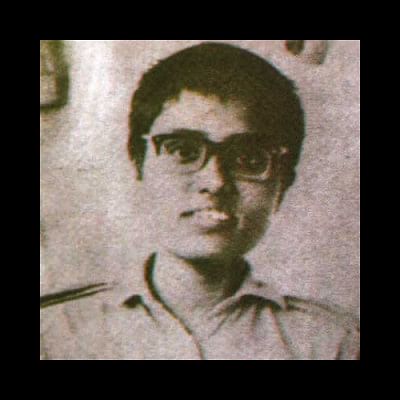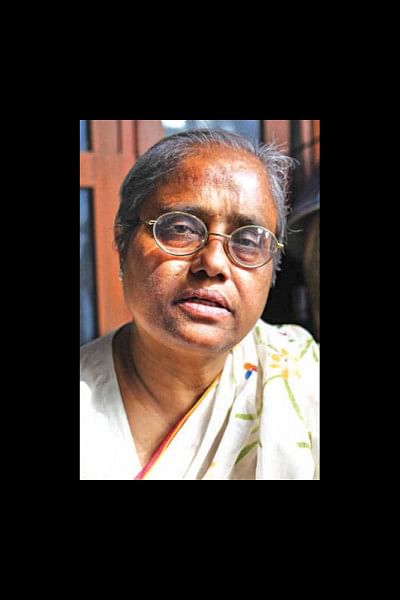"When the war was over, our struggle ended but the struggle of the Biranganas had just begun."

The Daily Star (TDS): Against what backdrop did you join the War of Liberation in 1971?
Shirin Banu Mitil (SBM): I was born in a politically active family. In 1954, my mother Selina Banu was elected an MP of the Jukta Front in Pabna. Both my parents were involved with the Communist party. I grew up in Pabna in my maternal grandparents' home. I was a Chhatra Union leader and the president of Pabna Zilla Chhatra Samity. In 1966, when Bangabandhu waged the movement with his six-point demand, the Communist party seemed hesitant about supporting the movement. But when Bangabandhu called for turning every home into a fort, Chhatra Union decided to join the war. We had the mental preparation to fight an armed battle. We knew very well that the Pakistanis would not let a Bangali come to power. We had the example of Vietnam War in front of us. To us, it was a war against imperialism. I didn't join the war on a whim. It was through a long process that I had become ready to fight in the war.
TDS: As a student leader, what were your activities prior to joining the war?
SBM: After getting directions from Bangabandhu on March 7, we, the leaders of Chhatra Union went to all the 18 thanas of Pabna in order to motivate people to participate actively in the resistance committee. We told them that it would be a long war and we would have to take up arms in our hands and fight together.
TDS: What were the challenges that you faced as a woman going to war?
SBM: I always talked about going to war and fight with arms, but when the war began, I was unable to participate because I am a woman. I was a second-year student at Pabna Edward College. One of my cousins said, “Mitu buji, you can go with us wearing a shirt and pant, like Pritilata Waddedar did.” I liked the idea of being disguised as a boy.
My aunt was my guardian. I went to her wearing my cousin's clothes. She said, “Come and stand in front of me.” As I did, she looked at me and said, “You can go, you don't look like a girl.”
I had short hair, I was lean and thin, and passed as a young boy.
TDS: Tell us about your experiences in the battlefield…
SBM: The situation of Pabna was different compared to other districts. There was no cantonment in Pabna. The Pakistan army came to Pabna from Rajshahi on March 25 and set up camps in the industrial area. They declared curfew and arrested people indiscriminately. What was special about Pabna was that there was coordination among all the groups of people: Nurul Quader, DC of Pabna; the leaders of District Awami League including Amjad Hossain, Abdur Rob (boga kaka), communist party leaders including Prashad Roy, Ronesh Maitra, NAP leaders including Aminul Islam Badshah. When the army entered the DC office, the local people retaliated against them. The common people and the political leaders together attacked the places where the military were staying. That's why from March 30 till April 10, there was no Pakistan army in Pabna.
I was at the forefront of the battle of Pabna Telephone Bhaban. We didn't have much arms and ammunition. All we had were koch (a fishing tool), boti (kichen knives), sticks, spears, a very small number of guns and locally made weapons. There were small scale fights with the Pakistan army all around Pabna. Later, my group shifted to the control room of Pabna. I arranged lodging and food for the freedom fighters and took the wounded freedom fighters to the hospital. It's not that I always fought with arms.

TDS: How did the fact that there was a girl disguised as a boy among the freedom fighters become public?
SBM: Around April 14/15, Manash Ghosh, a journalist of The Statesman, an Indian newspaper, came to Pabna. He wanted to know whether there were any women freedom fighters. Aminul Islam Badshah, the general secretary of NAP, knew that I was disguised as a boy. As I was present there among other freedom fighters, Aminul Islam Badshah said, “She is here.” Nurul Kader, the DC of Pabna, was staring at all of us, trying to find out who the girl was. At this I smiled and he understood right away that it was me. Manosh Ghosh took my interview which was published on April 12 in The Statesman along with my photograph. Later, Debdulal Bandyopadhay spoke about me on the Shadhin Bangla Betar Kendro. So my presence in the war was made public.
When the Pakistan military forces entered Pabna on April 10, we crossed the river Padma and moved towards Kushtia. From Kushtia we went to Chuadanga. Then we crossed the border, went to Kolkata and reported to the Shohayokh Samity office. Aminul Islam Badshah, Jahid Hasan and three others were with me. People from various institutions of Kolkata and other places came to that office with money and other aid to help run the war operations in Bangladesh. I was sitting on the floor with others, eagerly waiting to know what our next move would be. Suddenly Abdul Kuddus Makhon entered the office, looked at the crowd, and said, “Isn't that Shirin Banu?” Everybody was surprised. He then added, “Her photo has been published in The Statesman a few days ago.” As my identity was revealed, I couldn't stay with the group anymore.
Aminul Islam Badshah took me to Ila Mitra. I stayed at her place from April 21 till May 31. During my stay with Ila Mitra, I would go to many places to mobilise public opinion in favour of our Liberation War. As a student leader and freedom fighter, I spoke at many meetings organised by various institutions, colleges and universities and the CPI. So, basically, I had been involved in armed battles for one month -- from March till April. Later, in Kolkata, I got involved in organising other kinds of work. I gave speeches, worked at the women's camp, etc.
TDS: As we know, many women and girls participated in the war actively. You must have come across some of them during the war…
SBM: Bangladesh government was formed on April 17, 1971. When I met Prime Minister Tajuddin Ahmed at his office, he told me that separate camps would be set up for the women freedom fighters. And accordingly, Gobra camp was set up. Sajeda Chowdhury was in charge of the camp. Girls from different places of Bangladesh came to the camp. Some of them were Class VII or VIII students.
Dr. Laila (who now works at Gonosastho Community Hospital) was a third year medical student. Her father was the chief of Detective Branch in Rajshahi. The military forces had killed her father, uncle and grandfather. So she came to the camp for training. She was determined to fight with arms and liberate the country.
Jennatunnesa Talukdar, a third-year student of Rajshahi University and wife of an Awami League leader, came to receive training.
Leena Chakraborty came along with her two sisters. Then there was this girl named Shabnam, a class VIII student.
There was Tripti, a thirteen-year-old orphan who came from Barisal. She used to work for a jatra group. There was Geeta Kar, Ira Kar and many others.
TDS: Women's role -- their participation in our War of Liberation -- always gets overlooked under the patriarchal dominant narratives of the war. Isn't it time that we wrote the history of the war based on the narratives of women freedom fighters?
SBM: Firstly, the history of our War of Liberation was written based on the sectors, as if only the military forces participated in the war. Where do the general people stand in the history of our Liberation War? Didn't they resist the Pak army? The gallantry awards -- Bir Protik, Bir Bikram – all went to the military officials. The participation of common people in our Liberation War has not been included in our history, let alone the participation of women freedom fighters.
I was attending a meeting when a woman came to me. She held my hands and said, “My brother-in-law did not let his 14-year-old daughter stay at home because the Pakistan army picked her up and took her to their camp.” I said, “Alas! Where was he when he should have protected her from the army? Now he is refusing to give her shelter and driving her away!”
There was this woman who came to give her testimony at the Gano Adalot. When her daughter's in-laws found out that her mother was a Birnagana, her daughter's husband left her. How will you know their story when our society is so hostile towards the Biranganas? It is good news that the government has recognised the Biranganas as freedom fighters. I think the Biranganas were the bravest of the freedom fighters. They sacrificed the most for the country; they went through the most heinous types of torture. For me it was easy to fight as a freedom fighter. I knew that if I got shot, I would die, but I wouldn't be tortured. I felt safe among the freedom fighters. When the war was over, our struggle ended but the struggle of the Biranganas had just begun. We write 'his story', not 'her story'. If we want to write about women's role in our Liberation War, we will have to change our mindset and look at things differently. It will not be possible until and unless the young generation comes forward and takes responsibility.
TDS: What was your vision of a free Bangladesh when you joined the war? Have your dreams come true?
SBM: Our dream was to liberate Bangladesh from the occupation of the Pakistani forces, and we did so. After our independence, I, along with a large number of students, went to study in the then Soviet Union with scholarship. In 1974, Bangabandhu came to Moscow. He told us, “Learn from them how to build a country.” We were so hopeful that socialism would be established in Bangladesh. But instead, we heard the news of Bangabandhu's killing in the morning of August 15, 1975. I still remember what Bangabandhu said when he came to attend a conference of Chhatra Union in 1974: “I would rather die like Allende than give in to America's influence.”
We dreamt of a secular Bangladesh. You tell me, is Bangladesh now a secular state?

 For all latest news, follow The Daily Star's Google News channel.
For all latest news, follow The Daily Star's Google News channel. 



Comments